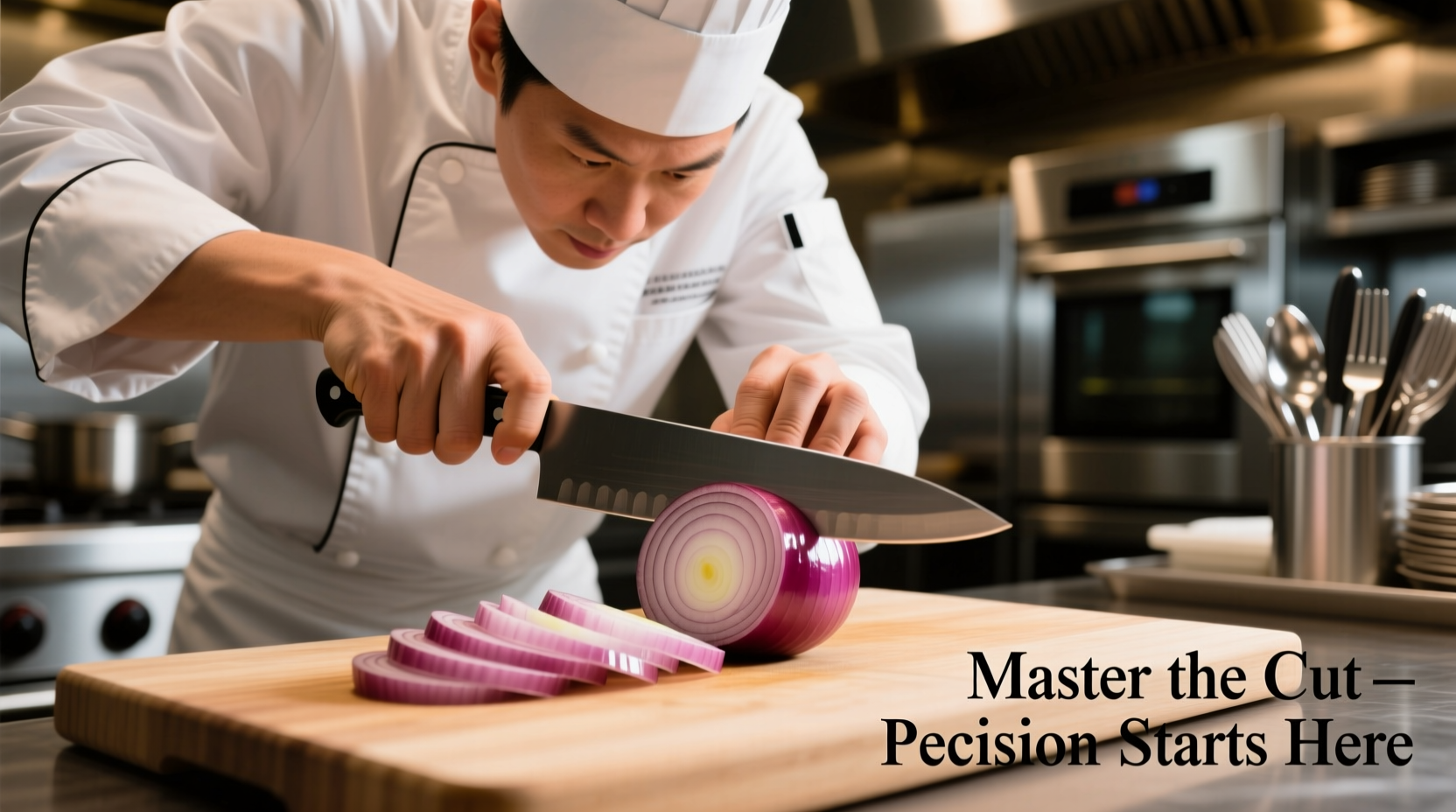Mastering onion cutting transforms your cooking experience. Forget the watery eyes and uneven chunks—this proven technique delivers consistent results while significantly reducing irritation. Whether you're preparing a simple salad or complex stew, proper onion preparation forms the flavor foundation of countless dishes.
Why Proper Onion Cutting Technique Matters
Onions contain volatile compounds that cause tearing when cells are ruptured during cutting. According to research from the Journal of Agricultural and Food Chemistry, the enzyme alliinase reacts with sulfur compounds when onion cells are damaged, creating the irritating syn-propanethial-S-oxide gas. Professional chefs minimize this reaction through specific cutting techniques that reduce cell damage.
| Cutting Method | Best For | Tear Reduction | Speed |
|---|---|---|---|
| Chef's Standard Technique | Most recipes requiring diced onions | ★★★★☆ | ★★★★☆ |
| Vertical Slice Method | Caramelizing, stir-fries | ★★★☆☆ | ★★★★★ |
| Mandoline Slicing | Salads, garnishes | ★★★☆☆ | ★★★☆☆ |
| Food Processor | Large batches, salsas | ★★☆☆☆ | ★★★★★ |
Essential Tools for Perfect Onion Cutting
You don't need specialized equipment—just three basic items:
- A sharp 8-inch chef's knife (dull knives crush cells, releasing more irritants)
- A stable cutting board (wood or soft plastic works best)
- A bowl of ice water (for pre-chilling onions)
Step-by-Step: The Professional Onion Cutting Method
Preparation Phase
- Chill the onion in ice water for 15-20 minutes (this slows enzyme activity)
- Remove dry outer skin but keep root end intact (this holds layers together)
- Place onion on cutting board with root end facing away from you
Cutting Technique
- Make a vertical cut through the center, keeping root end attached
- Lay each half flat side down and make horizontal cuts toward root (don't cut through)
- Make vertical slices from top to root end
- Finally, dice by cutting across the vertical slices

Advanced Cutting Methods for Specific Dishes
Different recipes require different cuts. Understanding these variations elevates your cooking:
Julienne Cut (Matchstick)
Ideal for stir-fries and garnishes. After halving the onion, make thin parallel slices lengthwise without cutting through the root. Rotate 90 degrees and slice again for uniform matchsticks.
Wedge Cut
Perfect for grilling or roasting. Cut onion vertically into quarters, keeping root intact. Separate layers carefully for even cooking.
Science-Backed Tips to Prevent Onion Tears
Based on research from the National Onion Association, these methods actually work:
- Cut near running water or under a vent to disperse the gas
- Use a very sharp knife to minimize cell damage
- Cut the root end last (it contains the highest concentration of enzymes)
- Work quickly to reduce exposure time
Common Onion Cutting Mistakes to Avoid
Even experienced cooks make these errors:
- Removing the root end too early (causes layers to separate)
- Using a dull knife (increases cell damage and tears)
- Cutting too slowly (prolongs exposure to irritants)
- Not chilling onions before cutting (allows enzymes to react faster)
When to Use Different Cutting Techniques
Understanding context boundaries improves your cooking results:
- Diced onions: For even cooking in sauces, soups, and salsas
- Sliced onions: When you want distinct onion pieces in stir-fries or sandwiches
- Minced onions: For maximum flavor distribution in meatloaf or burgers
- Wedges: When onions are the star ingredient, like in grilled dishes
Evolution of Onion Cutting Techniques
Professional kitchen methods have evolved significantly:
- 1950s-1970s: Basic chopping with minimal technique focus
- 1980s-1990s: Introduction of standardized culinary school methods
- 2000s: Scientific understanding of tear reduction techniques
- 2010s-Present: Precision cutting for molecular gastronomy applications
Putting It All Together: Your Perfect Onion Cutting Workflow
Follow this sequence for optimal results:
- Chill onion (15-20 minutes)
- Prepare your sharp knife and stable cutting surface
- Remove outer skin while preserving root end
- Make initial vertical cut through center
- Execute horizontal cuts, then vertical slices
- Dice to desired size
- Store unused portions properly (in airtight container for 7-10 days)











 浙公网安备
33010002000092号
浙公网安备
33010002000092号 浙B2-20120091-4
浙B2-20120091-4